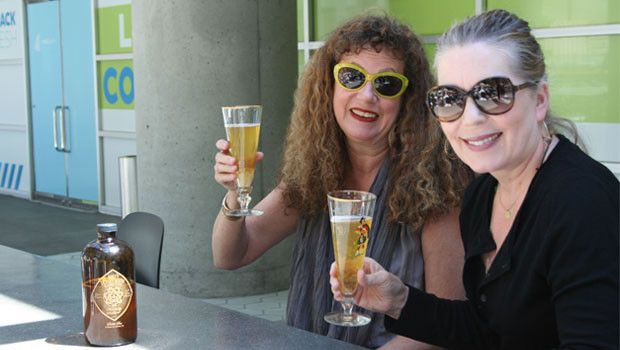Book review: There’s more to us than meets the eye

‘Amateur microbiome geeks’ Jane Grafton and Dona Cutsogeorge share a book that demystifies the science behind the craze.
I Contain Multitudes: The Microbes Within Us and a Grander View of Life
By Ed Yong
Penguin / Random House, New York 2016
Dona Cutsogeorge: One of the perks of working at Kaiser Permanente Washington Health Research Institute is being part of a community of people with far-ranging interests and hobbies. Lately, the two of us have become amateur microbiome geeks so we decided to review the wildly popular book, I Contain Multitudes: The Microbes Within Us and a Grander View of Life by Ed Yong.
Jane Grafton: I find scientific discovery in the realm of the human genome fascinating, partly because of my role on the eMERGE project. Research into the human microbiome is an extension of this. The microbiome is defined as the collective genomes of the microbes (composed of bacteria, bacteriophage, fungi, protozoa and viruses) that live inside and on the human body.” Compelling — as it considers the inter-related nature of all that comprises ourselves.
Dona: The microbiome was bigger than what I’d envisioned. I like this explanation from a 2013 PubMed paper by Ursell, et al: “The human microbiota consists of the 10–100 trillion symbiotic microbial cells harbored by each person, primarily bacteria in the gut; the human microbiome consists of the genes these cells harbor.”
Ed Yong’s book is roughly divided into two halves. The first half delves into the history of animal-microbe partnerships, with the second musing about directions for its applications. One of the things I loved about this book is that it’s compulsively readable and enjoyable. He’s a science writer for The Atlantic who tells great tales!
The history of the microbiome includes great vignettes about Antonie van Leeuwenhoek. A Dutch haberdasher by day, his after-hours passion was creating the lenses which became prototypes for the modern microscope. He loved looking at everything under his lenses, including a white substance he noticed in his mouth. (Plaque. I’m guessing there was a lot of it.) He scraped some off his teeth to examine it under the magnifying lenses. Lo and behold, it was alive with life. He then figured out he could kill the life forms by dousing the plaque with wine vinegar. This was early antiseptic research.
After much discussion on bacteria itself, the author moves into health and disease, and our understanding of bacteria’s role. He lays the groundwork of the mostly negative perspective (“dirt, disease, death”) so that we can later learn about the positive aspects. Something that surprised me: Fecal transplants are not new. They’ve been recorded as far back as 1,700 years ago in China.
The concept of prebiotics (substances that selectively nourish/increase beneficial microbes) in Yong’s book was an eye opener. These render introduced microbes more effective.
The mechanism of traditional folk remedies is intriguing. Yong delves into the history of these. Fecal microbiota transplant (FMT)(as mentioned above) in use for 1700 years, and a contemporary therapy for intransigent C. diff infections, proved more effective than treatment with the antibiotic vancomycin in a recent randomized clinical trial. As with genomic medicine in general, such therapies will become more effective by personalizing them to a patient’s particular microbiome. Potential exists for creating microbes that diagnose, as well as treat, conditions, including inflammatory diseases, cancers, and mood disorders. Folk legends also tout the benefit of live yogurt, consumed by Bulgarian peasants who had incredibly long lifespans. Florence Nightingale extolled the benefit of open windows in hospitals, as an infection control method.
Beyond treating individuals, microbes are used to tackle virulent public health problems, such as dengue fever; mosquitoes treated with the Wolbachia bacteria are prevented from carrying dengue fever viruses, and potentially other diseases such as Zika and malaria.
The concept of microbiome is being extended beyond the individual to include realms such as buildings (hospitals, gyms, dorms, homes) and aquatic environments. Beneficial microbe-impregnated balls (akin to guerilla gardening seed bombs) are introduced into building structures, as are microbes that attack molds that follow flooding.
Forensic applications include tracking of personal microbial footprints.
Dona: Contemplating endless, myriad “communities” inside the human body made me feel strangely out of touch with my own self, yet intensely curious about my biological makeup. What (and who) makes me the person I am? I’ve always loved Walt Whitman’s “Song of Myself,” the poem from which Yong’s title I Contain Multitudes was taken, and it couldn’t be a better reference: “One world is aware and by far the largest to me, and that is myself,” Whitman wrote.
Jane: I’ve been receptive to hype about the benefits of consuming probiotics — my own home-brewed kombucha (holler if you’d like a complementary SCOBY), live yogurt products, my super-fermenter nephew’s sauerkraut, and more. Yong’s book does a good job demystifying the science behind the craze.
Dona Cutsogeorge is a communications coordinator for KPWHRI’s MacColl Center for Health Care Innovation. Jane Grafton is a KPWHRI programmer/analyst.
Learn more about Kaiser Permanente Washington Health Research Institute. Sign up for our free monthly newsletter.


